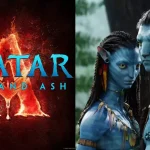Top 10 Best Animated Films of All Time

Related Movies:
Related Movies:
Related Movies:
Related Movies:
Related Movies:
Related Movies:
Related Movies:
Niko 2: Little Brother, Big Trouble (2012) – Movie Review
Starring: Mikko Kivinen, Kari Hietalahti, Heikki Kinnunen, Kaisa Hagelberg
Genre: Animation, Adventure, Family
Rating: PG
Plot Summary:
Niko 2: Little Brother, Big Trouble is the sequel to the 2008 animated film Niko & The Way to the Stars. The story continues the adventures of Niko, a young reindeer with dreams of becoming like his father, who is one of Santa Claus’s flying reindeer. In this sequel, Niko is now living with his mother, and his life is turned upside down when his estranged father, the famous reindeer, unexpectedly arrives for a visit.
However, Niko’s world is shaken further when he learns that his mother has a new boyfriend, the slightly pompous reindeer, Phil (voiced by Kari Hietalahti), and that he will soon have a new little brother. Feeling left out and unsure of his place, Niko decides to go on an adventure to prove his worth to his family and save his father, who is in danger after being kidnapped by a villainous group of wild animals.
With the help of his loyal friend, the mouse-who-wants-to-be-a-hero, Julius (Heikki Kinnunen), Niko embarks on a thrilling journey full of challenges, discovering the true meaning of family, teamwork, and acceptance along the way.
Review:
Niko 2: Little Brother, Big Trouble is a delightful animated sequel that blends humor, heart, and adventure in a fun-filled package. The film carries forward the charm of the first movie while adding a deeper emotional element, especially revolving around family dynamics, sibling rivalry, and personal growth.
The animation is vibrant and visually appealing, bringing the snowy landscapes and the magical world of reindeer and animals to life. The characters, both old and new, are lovable and relatable. Niko’s struggle with feeling overshadowed by his father and his new family situation is something many viewers, especially younger ones, will be able to empathize with. His journey to prove himself provides the emotional backbone of the story.
The addition of Niko’s new little brother adds both humor and heart to the story. The sibling rivalry between Niko and the new baby reindeer adds to the tension, while also providing moments of warmth as Niko grows into his new role as an older sibling. Julius, Niko’s ever-faithful mouse friend, continues to provide comic relief, adding lightheartedness to the film’s more serious moments.
The voice acting is solid, with the characters’ emotions coming through clearly, adding depth to the animation. The story itself is simple but filled with positive messages about courage, self-acceptance, and the importance of family. The villains, while somewhat generic, still provide the necessary conflict and danger, making the action sequences enjoyable for younger viewers.
While the plot may feel predictable at times, the film’s charm lies in its likable characters and the heartwarming resolution of Niko’s journey. The themes of overcoming insecurities and learning to accept new changes in life are well-executed and will resonate with both kids and their parents.
Ice Age (2002) – Movie Review
Starring: Ray Romano, John Leguizamo, Denis Leary, Queen Latifah, Sean William Scott
Genre: Animation, Adventure, Comedy, Family
Rating: PG
Plot Summary:
Ice Age is a beloved animated film set during the prehistoric Ice Age, following the unlikely friendship between three animals: Manny (Ray Romano), a grumpy woolly mammoth, Sid (John Leguizamo), a talkative and clumsy sloth, and Diego (Denis Leary), a cunning saber-toothed tiger. The trio forms a bond as they embark on a journey to return a human baby to his tribe after the child’s family is attacked by a pack of saber-toothed tigers.
Along the way, the group encounters various challenges, including harsh environments, dangerous predators, and their own differences. As they travel, they learn to trust and depend on one another, with each character growing and evolving in their own way. At its heart, Ice Age is about the power of friendship and teamwork in the face of adversity.
Review:
Ice Age is a heartwarming and hilarious animated film that appeals to both children and adults. The film’s charm lies in its unique characters, quirky humor, and the unexpected friendships that form throughout the story. The animation, for its time, was groundbreaking, with the icy landscapes, mammoths, and saber-toothed tigers brought to life in a way that felt both charming and realistic. The character designs are creative and fun, adding to the humor and emotional appeal of the film.
Ray Romano’s voice work as Manny gives the character a perfect balance of gruffness and warmth, while John Leguizamo brings a lovable and goofy energy to Sid. Denis Leary’s portrayal of Diego provides the perfect foil to Sid’s energy, offering a more serious, yet equally relatable, character. The dynamic between the three leads is the heart of the movie, and their evolving relationships drive the story forward in a way that feels natural and emotionally satisfying.
The film’s humor is quick and clever, with plenty of physical comedy and witty dialogue that both kids and adults will appreciate. Sid’s slapstick antics provide a lot of the film’s comedic moments, while Manny’s more serious and reluctant nature adds a nice contrast to the group dynamic. The subplot involving the baby is also full of heart, as the animals’ journey to return the child becomes a journey of self-discovery and growth.
The animation itself is gorgeous, with the icy landscapes of the Ice Age era depicted with great detail. The film’s cold, barren world is balanced by the warmth of the characters’ friendships, making for a visually and emotionally engaging experience. The musical score, composed by John Powell, complements the visuals with its sweeping, emotional orchestration, adding to the grandeur of the film’s setting.
While the plot may be a bit predictable at times, Ice Age manages to surprise with its emotional depth, especially in the development of the characters’ relationships. The themes of family, friendship, and overcoming differences resonate deeply, making the film more than just a fun adventure; it’s also a meaningful exploration of bonding and teamwork.
The Angry Birds Movie 2 (2019) – Movie Review
Starring: Jason Sudeikis, Josh Gad, Bill Hader, Leslie Jones, Rachel Bloom
Genre: Animation, Comedy, Family
Rating: PG
Plot Summary:
The Angry Birds Movie 2 is the sequel to the 2016 hit The Angry Birds Movie and continues the story of Red (voiced by Jason Sudeikis), the irritable but lovable bird, and his friends Chuck (Josh Gad) and Bomb (Danny McBride). After the events of the first movie, the birds now have to face a new threat from a neighboring island—Eagle Island, home to the scheming Zeta (Leslie Jones), a villainous eagle who has been trying to take over Bird Island and Piggy Island with a series of frozen weapons.
In order to stop Zeta from her icy plans, Red and his team of feathered friends must join forces with their former enemies, the pigs, led by Leonard (Bill Hader). Among the pigs is the tech-savvy, often nerdy pig named Eugenio (voiced by Zach Woods), who is tasked with developing new gadgets for the mission. This reluctant alliance leads to a series of wild and fun adventures, with Red, Chuck, Bomb, Leonard, and the others working together to save their islands before Zeta’s freeze ray turns them into popsicles.
Review:
The Angry Birds Movie 2 is a fun, fast-paced, and surprisingly heartwarming sequel that improves upon its predecessor in many ways. The humor is sharper, the animation is more vibrant, and the emotional stakes feel higher this time around. While the film is clearly aimed at younger audiences, it does a great job of balancing humor, adventure, and character development in a way that makes it enjoyable for both kids and adults.
One of the highlights of the film is the dynamic between Red and his former enemies, the pigs. The uneasy alliance adds a fun layer of tension and comedy, as the characters work together while still harboring distrust and rivalry. Jason Sudeikis continues to bring his signature sarcastic energy to Red, while Josh Gad’s Chuck is as energetic and funny as ever. The introduction of Zeta, voiced by Leslie Jones, as the new villain adds an entertainingly over-the-top character to the mix. Zeta’s character is a fun combination of menace and humor, which makes her a memorable antagonist.
The animation is bright, colorful, and full of quirky, fast-paced action. The film’s visual style reflects the chaotic energy of the Angry Birds franchise, with explosive action sequences, vibrant landscapes, and zany slapstick humor. The movie never slows down, keeping the energy high with constant comedic moments and eye-catching visuals.
The soundtrack, with fun and upbeat songs, complements the fast-paced nature of the film and adds to the overall enjoyment. There are plenty of visual gags, references to the original mobile game, and comedic one-liners that will keep audiences laughing throughout. The animation sequences, particularly in the ice storm battle, are particularly well-done, adding extra excitement to the adventure.
At its core, The Angry Birds Movie 2 is about friendship, teamwork, and learning to trust others—even if they’re your enemies. The film teaches valuable lessons about cooperation, even in the face of rivalry, and about how working together can help overcome even the most formidable threats.
Trolls (2016) – Movie Review
Starring: Anna Kendrick, Justin Timberlake, Zooey Deschanel, Christopher Mintz-Plasse
Genre: Animation, Adventure, Comedy, Family, Musical
Rating: PG
Plot Summary:
Trolls is an animated musical comedy that takes audiences to a colorful, whimsical world where the Trolls, a cheerful and optimistic group of creatures, live. The Trolls are known for their love of singing, dancing, and hugging, and they are led by Princess Poppy (voiced by Anna Kendrick). However, the Trolls’ idyllic lives are disrupted when a group of Bergens—grumpy, giant creatures who believe that eating a Troll will make them happy—kidnap several of the Trolls.
Determined to save her friends, Princess Poppy teams up with the grumpy and more cautious Branch (voiced by Justin Timberlake), a Troll who prefers to stay out of the limelight. Together, they embark on a thrilling journey to rescue the captured Trolls and defeat the Bergens. Along the way, Poppy and Branch learn about friendship, teamwork, and the importance of finding happiness from within.
Review:
Trolls is a visually stunning, energetic, and heartwarming film that blends vibrant animation with catchy musical numbers, making it an unforgettable experience for children and adults alike. The world of the Trolls is bright, cheerful, and overflowing with color, with every frame bursting with detail and fun. The designs of the characters themselves, with their fluffy hair and colorful appearances, are both charming and playful, perfectly capturing the whimsy of the story.
The film’s music is one of its standout features. Featuring a mix of original songs and classic hits, the soundtrack is packed with catchy tunes, including the infectious “Can’t Stop the Feeling!” by Justin Timberlake, which became a worldwide hit. The film’s musical numbers, full of dancing and vibrant visuals, keep the energy high and add to the film’s feel-good vibe. Anna Kendrick and Justin Timberlake both deliver strong vocal performances, with Kendrick’s bubbly voice bringing Poppy to life and Timberlake’s more reserved style perfectly complementing Branch’s character.
The message of Trolls is simple yet powerful—emphasizing the importance of positivity, friendship, and the idea that true happiness comes from within. The film does a great job of showing how two very different characters can work together, learning from each other and finding common ground. Poppy’s unwavering optimism contrasts with Branch’s skepticism, and their evolving relationship is the heart of the film.
The humor in Trolls is lighthearted and accessible to both children and adults, with plenty of silly jokes, slapstick comedy, and visual gags. While the plot itself is straightforward and predictable, the film’s charm lies in its colorful world, lively characters, and feel-good messages about overcoming challenges with a positive attitude.
Ratatouille (2007) – Movie Review
Starring: Patton Oswalt, Ian Holm, Lou Romano, Brian Dennehy, Peter O’Toole
Genre: Animation, Comedy, Family
Rating: G
Plot Summary:
Ratatouille follows the story of Remy, a rat with an extraordinary sense of taste and a dream of becoming a world-class chef in Paris. Despite the general disdain for rats in the culinary world, Remy’s passion for food drives him to pursue his dream of becoming a renowned chef. Living in the sewers beneath Paris with his family, Remy finds himself in an unlikely place when he stumbles upon Gusteau’s restaurant, once a thriving establishment known for its gourmet meals.
After an unexpected encounter with Linguini (Lou Romano), a clumsy and inexperienced kitchen worker, Remy forms a secret partnership with him, controlling his movements from under his hat. Together, they work to bring Gusteau’s restaurant back to its former glory. However, Remy’s secret is at risk of being exposed, and he must navigate the challenges of maintaining his culinary ambitions while keeping his identity hidden. Along the way, Remy learns the true meaning of greatness, and the importance of following his passion, no matter how unconventional it may seem.
Review:
Ratatouille is a visually stunning and heartfelt film that blends humor, ambition, and a love for food. Directed by Brad Bird and produced by Pixar, the movie excels in both its animation and storytelling. The characters are charming, with Remy being a particularly memorable protagonist. His journey from a simple rat to a world-class chef serves as an inspiring tale about pursuing one’s dreams, regardless of the obstacles.
The animation in Ratatouille is some of the finest in Pixar’s portfolio, capturing the beauty and grandeur of Paris while also giving the audience a behind-the-scenes look at the chaos and creativity of a professional kitchen. The way the food is animated is nothing short of mouthwatering, making the film an absolute visual treat. Every dish is lovingly depicted, making the viewer appreciate the art of cooking even more.
Patton Oswalt’s voice performance as Remy is both heartfelt and relatable. Remy’s passion for food and his desire to achieve greatness despite his limitations resonate deeply with audiences. Linguini, voiced by Lou Romano, is the perfect foil to Remy, bringing a mix of comedy, vulnerability, and charm to the story. The interactions between the two characters are delightful, with Remy’s silent control over Linguini creating both humorous and touching moments.
The film’s antagonist, Anton Ego (Peter O’Toole), a cynical food critic, adds a layer of tension to the story. His character serves as a metaphor for the film’s theme of artistic integrity and the harshness of criticism. The climactic scene where Ego tastes Remy’s ratatouille is one of the film’s most poignant moments, symbolizing the power of food to transcend boundaries and connect people.
The score by Michael Giacchino complements the film beautifully, with sweeping orchestral music that evokes the charm and romance of Paris while also capturing the intensity of the kitchen scenes.
Snow White and the Seven Dwarfs (1937) – Movie Review
Starring: Adriana Caselotti, Lucille La Verne, Roy Atwell, Stuart Buchanan
Genre: Animation, Fantasy, Family, Musical
Rating: G
Plot Summary:
Snow White and the Seven Dwarfs is the first-ever full-length animated feature film produced by Walt Disney and is considered a timeless classic. The story is based on the fairy tale by the Brothers Grimm and follows Snow White, a beautiful and kind princess who is forced to flee her stepmother, the Evil Queen, after the Queen’s magic mirror reveals that Snow White is now the fairest in the land.
Driven by jealousy and insecurity, the Evil Queen orders a huntsman to kill Snow White, but he cannot bring himself to harm her. Snow White escapes into the forest, where she finds refuge with seven dwarfs who live in a small cottage. While Snow White bonds with the dwarfs and brings joy to their lives, the Evil Queen discovers that Snow White is still alive and uses magic to disguise herself as an old peddler woman. She tricks Snow White into eating a poisoned apple, which puts Snow White into a deep, enchanted sleep.
The only way to break the spell is through true love’s kiss, and it is Prince Charming, who has fallen in love with Snow White, who ultimately awakens her. The film ends with Snow White and her prince living happily ever after.
Review:
Snow White and the Seven Dwarfs is a pioneering piece of cinema history and remains one of the most influential animated films of all time. Disney’s first feature-length animated film set the standard for animated movies to come, showcasing the studio’s unmatched ability to combine beautiful animation, memorable characters, and a magical story.
The animation in Snow White is stunning for its time, with beautifully painted backdrops, fluid character movements, and charming details that bring the fairy tale world to life. Snow White’s character design, with her iconic red lips, black hair, and yellow and blue dress, became instantly recognizable and is still an enduring image in pop culture.
The music in the film is an integral part of its charm. Songs like “Heigh-Ho,” “Someday My Prince Will Come,” and “Whistle While You Work” are catchy and timeless, and they help tell the story and establish the film’s whimsical, heartwarming tone. The songs also serve to enhance the emotional stakes of the film, especially the haunting “Grim Grinning Ghosts” which plays when the Evil Queen makes her dark transformation.
Snow White, voiced by Adriana Caselotti, is the epitome of innocence and kindness. Her voice performance captures the character’s sweetness and purity, making her both relatable and endearing. The seven dwarfs—Doc, Grumpy, Happy, Sleepy, Bashful, Sneezy, and Dopey—are some of the most beloved supporting characters in animation history. Each dwarf has a distinct personality, adding humor and heart to the story, while also helping Snow White feel less isolated during her time in the forest.
The Evil Queen, voiced by Lucille La Verne, is one of Disney’s most memorable villains. Her transformation into the old peddler woman is both creepy and iconic, and her desire for beauty and power fuels her evil actions. The tension between Snow White’s purity and the Queen’s jealousy creates a gripping contrast throughout the film, and the Queen’s downfall is a fitting conclusion to the story.
101 Dalmatians (1961) – Movie Review
Starring: Rod Taylor, Cate Bauer, Betty Lou Gerson, J. Pat O’Malley
Genre: Animation, Adventure, Comedy, Family
Rating: G
Plot Summary:
101 Dalmatians is a classic Disney animated film that tells the heartwarming and adventurous story of Pongo and Perdita, two Dalmatians living in London with their owners, Roger and Anita. The couple’s life is turned upside down when Perdita gives birth to 15 adorable puppies. However, their joy is short-lived as the notorious and villainous Cruella de Vil (voiced by Betty Lou Gerson) becomes obsessed with making a fur coat from the puppies’ spotted fur.
When Cruella kidnaps the puppies and takes them to her remote mansion, Pongo and Perdita embark on an epic journey to rescue their puppies. Along the way, they receive help from a network of animals, including other dogs, who lend their paws to free the puppies from Cruella’s clutches. As the dogs race to save their family, they discover the power of teamwork, loyalty, and love.
Review:
101 Dalmatians is a timeless Disney classic that has captured the hearts of audiences for generations. The film stands out for its simple yet engaging story, its memorable characters, and its charming animation. Disney’s ability to bring an animal-filled world to life with humor, adventure, and heart makes this film one of its most beloved.
The animation style in 101 Dalmatians is distinctive and bold, with its use of sketchy, minimalist backgrounds and fluid character designs. The movie marked a departure from Disney’s previous elaborate and detailed animation techniques, using a more streamlined and economical approach that still feels fresh and stylish. The iconic look of the Dalmatians with their black spots is one of the film’s standout visual features, and the playful design of the dogs makes them instantly lovable.
The character of Cruella de Vil is one of Disney’s most memorable villains. Voiced by Betty Lou Gerson, Cruella is over-the-top, dramatic, and cruel, making her a perfect foil to the loving, gentle nature of the Dalmatians. Her obsession with fur and her monstrous personality make her a villain that’s both menacing and darkly amusing. Her character has become synonymous with villainy in pop culture, and her distinctive laugh and fashion sense remain iconic.
Pongo and Perdita, voiced by Rod Taylor and Cate Bauer, are the film’s heroes, and their love for their puppies is at the heart of the story. Their journey to rescue their stolen puppies is both suspenseful and touching, showcasing the importance of family and loyalty. The relationship between the two dogs feels genuine, and their determination to save their pups makes them incredibly endearing.
The film’s pacing is spot-on, keeping the adventure moving while also allowing time for moments of humor, character development, and emotional depth. The dogs’ network of animal allies, from the helpful cat to the group of countryside dogs, adds a sense of camaraderie and teamwork to the story. The clever ways in which the dogs communicate and collaborate make for some entertaining moments that are enjoyable for both kids and adults.
The music, including the memorable “Cruella De Vil” song, is another highlight of the film. It’s catchy, fun, and helps to reinforce the personalities of the characters, especially Cruella’s villainy.
Alice in Wonderland (2010) – Movie Review
Starring: Mia Wasikowska, Johnny Depp, Helena Bonham Carter, Anne Hathaway, Crispin Glover
Genre: Fantasy, Adventure, Family
Rating: PG
Plot Summary:
Alice in Wonderland (2010), directed by Tim Burton, is a reimagining of Lewis Carroll’s classic tale, blending elements of fantasy, adventure, and surrealism. The film follows 19-year-old Alice Kingsleigh (Mia Wasikowska), who finds herself falling down a rabbit hole into a strange, whimsical world she last visited as a child. However, Alice doesn’t quite remember her previous adventure in Wonderland and is unsure of her role in this fantastical realm.
In Wonderland, the inhabitants believe Alice is the “Alice” foretold in a prophecy, destined to defeat the Red Queen (Helena Bonham Carter) and restore order to the land. Along her journey, Alice encounters a variety of eccentric and memorable characters, including the Mad Hatter (Johnny Depp), the White Rabbit (Michael Sheen), the Cheshire Cat (Stephen Fry), and the White Queen (Anne Hathaway). As she navigates this bizarre world, Alice must confront her fears, discover her true strength, and ultimately decide if she can fulfill her destiny and bring peace to Wonderland.
Review:
Alice in Wonderland (2010) is a visually stunning and imaginative film that captures Tim Burton’s signature dark, whimsical style. The film combines the quirky, dreamlike quality of the original story with Burton’s unique approach to storytelling, resulting in a movie that is both familiar and refreshingly new. The world of Wonderland is brought to life with vibrant visuals, intricate costumes, and breathtaking CGI, making the fantastical world feel both magical and surreal.
Mia Wasikowska’s portrayal of Alice is both graceful and strong. Her character evolves from a young woman unsure of her place in the world into a confident, brave individual who embraces her role as a leader. Wasikowska’s understated performance allows Alice’s character to feel grounded amidst the eccentricity of Wonderland. Johnny Depp’s Mad Hatter is a quirky, lovable figure who brings an air of mystery and eccentricity to the film. Depp’s portrayal of the character, with his wild appearance and unpredictable behavior, adds depth to the film’s surreal atmosphere.
Helena Bonham Carter’s portrayal of the Red Queen is one of the film’s highlights. With her oversized head and monstrous ego, the Red Queen is both comical and terrifying, and Carter perfectly embodies the character’s childlike tantrums and sinister nature. The contrast between the Red Queen and Anne Hathaway’s serene, ethereal White Queen makes for an interesting dynamic, adding layers of complexity to the film’s exploration of good versus evil.
The visual effects and costume design in Alice in Wonderland are extraordinary, with Wonderland’s landscapes being both enchanting and otherworldly. The fantastical creatures, like the Cheshire Cat and the Bandersnatch, are brought to life through cutting-edge CGI, making them both visually impressive and fitting for the world Burton has crafted.
The film’s themes of self-discovery, courage, and personal growth are explored in a way that resonates with both children and adults. Alice’s journey mirrors the challenges many face in their own lives, where overcoming self-doubt and embracing one’s true potential can lead to personal transformation. While the narrative may not follow the exact structure of Carroll’s original works, Burton’s adaptation offers a fresh take on the beloved tale that feels relevant and accessible to modern audiences.
The film’s pacing, however, can feel uneven at times, and some of the supporting characters—while visually striking—could have been further developed. The story itself can be a bit meandering, with Alice’s journey feeling less focused compared to more traditional adventure films.
Maleficent (2014) – Movie Review
Starring: Angelina Jolie, Elle Fanning, Sharlto Copley, Sam Riley, Imelda Staunton
Genre: Fantasy, Adventure, Family
Rating: PG
Plot Summary:
Maleficent is a dark fantasy reimagining of Disney’s classic animated film Sleeping Beauty (1959), told from the perspective of the iconic villain, Maleficent (played by Angelina Jolie). The film explores the origins of the misunderstood fairy and offers a fresh take on the classic fairy tale.
Maleficent begins as a kind and pure-hearted young fairy who lives in the peaceful Moors, a magical realm filled with mystical creatures. However, her life changes when a young human boy named Stefan (Sharlto Copley) betrays her trust in a quest for power. As Stefan rises to become king, he abandons Maleficent, leaving her heartbroken and vulnerable. Consumed by rage and pain, Maleficent transforms into the powerful, vengeful figure that everyone remembers, cursing Stefan’s infant daughter, Aurora (Elle Fanning), to fall into a deep sleep on her 16th birthday after pricking her finger on a spinning wheel.
However, as the years go by, Maleficent begins to develop a deep, complex connection with Aurora, who grows up unaware of the curse that hangs over her. Maleficent’s feelings of guilt and compassion challenge her earlier hatred, and she struggles to protect Aurora from her own curse. As the film unfolds, Maleficent’s backstory is revealed, showing the complexities of love, betrayal, and redemption.
Review:
Maleficent is a visually stunning film that reimagines the classic fairy tale with a more nuanced, sympathetic portrayal of the villain. Angelina Jolie’s performance is undoubtedly the film’s standout, with her portrayal of Maleficent being both powerful and emotionally compelling. Jolie brings depth to the character, making her not just a villain but a tragic figure shaped by betrayal and loss. Her imposing presence, combined with a sense of vulnerability, makes Maleficent a character the audience can both fear and empathize with.
The film’s visuals are breathtaking, with the lush landscapes of the Moors and the fantastical creatures that inhabit it. The special effects are well-executed, and the world-building creates a magical atmosphere that feels fresh and imaginative. The design of Maleficent’s iconic horns is striking, and the transformation sequences are some of the film’s most visually captivating moments.
Elle Fanning’s portrayal of Princess Aurora is sweet and innocent, offering a contrast to Maleficent’s darker, more complicated character. The relationship between Maleficent and Aurora evolves throughout the film, and it is this dynamic that serves as the emotional heart of the story. The film flips the narrative of Sleeping Beauty, making Aurora not just a passive character waiting for a prince to save her, but someone who forms a bond with Maleficent and helps heal her heart.
The supporting cast, including Sam Riley as Maleficent’s loyal crow-turned-man, Diaval, adds humor and warmth to the story. Sharlto Copley’s portrayal of King Stefan provides a traditional antagonist, though his motivations can sometimes feel one-dimensional compared to the complexity of Maleficent’s character.
The film’s themes of love, betrayal, and redemption add depth to the classic fairy tale, transforming it from a simple story of good vs. evil to a more intricate exploration of relationships and personal growth. Maleficent’s journey is one of self-discovery, where she learns the power of forgiveness and the capacity for love, even after being wronged.
The soundtrack, composed by James Newton Howard, complements the film’s tone perfectly, with sweeping orchestral pieces that enhance both the emotional and action-packed moments.











